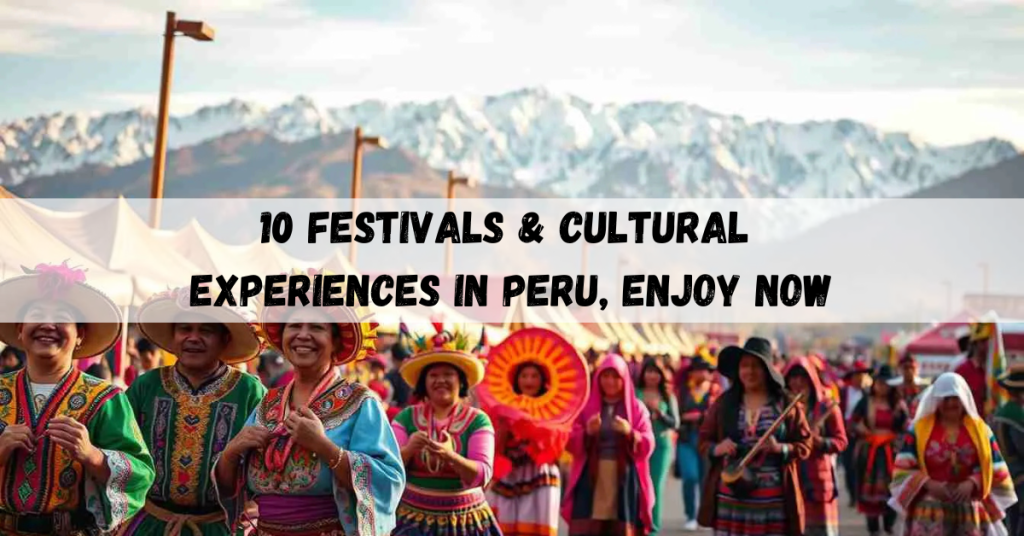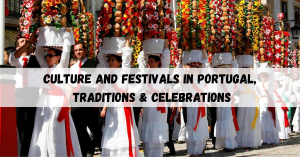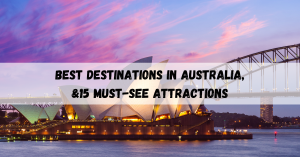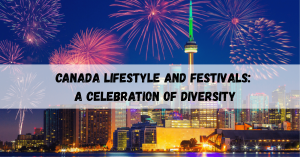Peru is a land of vibrant festivals and cultural experiences, where ancient Peruvian traditions and customs blend with modern influences. From Inti Raymi Festival in Cusco to Carnival in Cajamarca, these celebrations showcase Peru’s rich heritage.
Visitors can explore Andean indigenous traditions, enjoy Peruvian music and dance, and witness religious events like the Lord of Miracles Procession in Lima. Whether you’re drawn to Catholic festivals in South America, folklore performances in Peru, or traditional Peruvian clothing, these cultural experiences in Peru offer unforgettable moments.
Traditional Festivals in Peru: A Celebration of Heritage
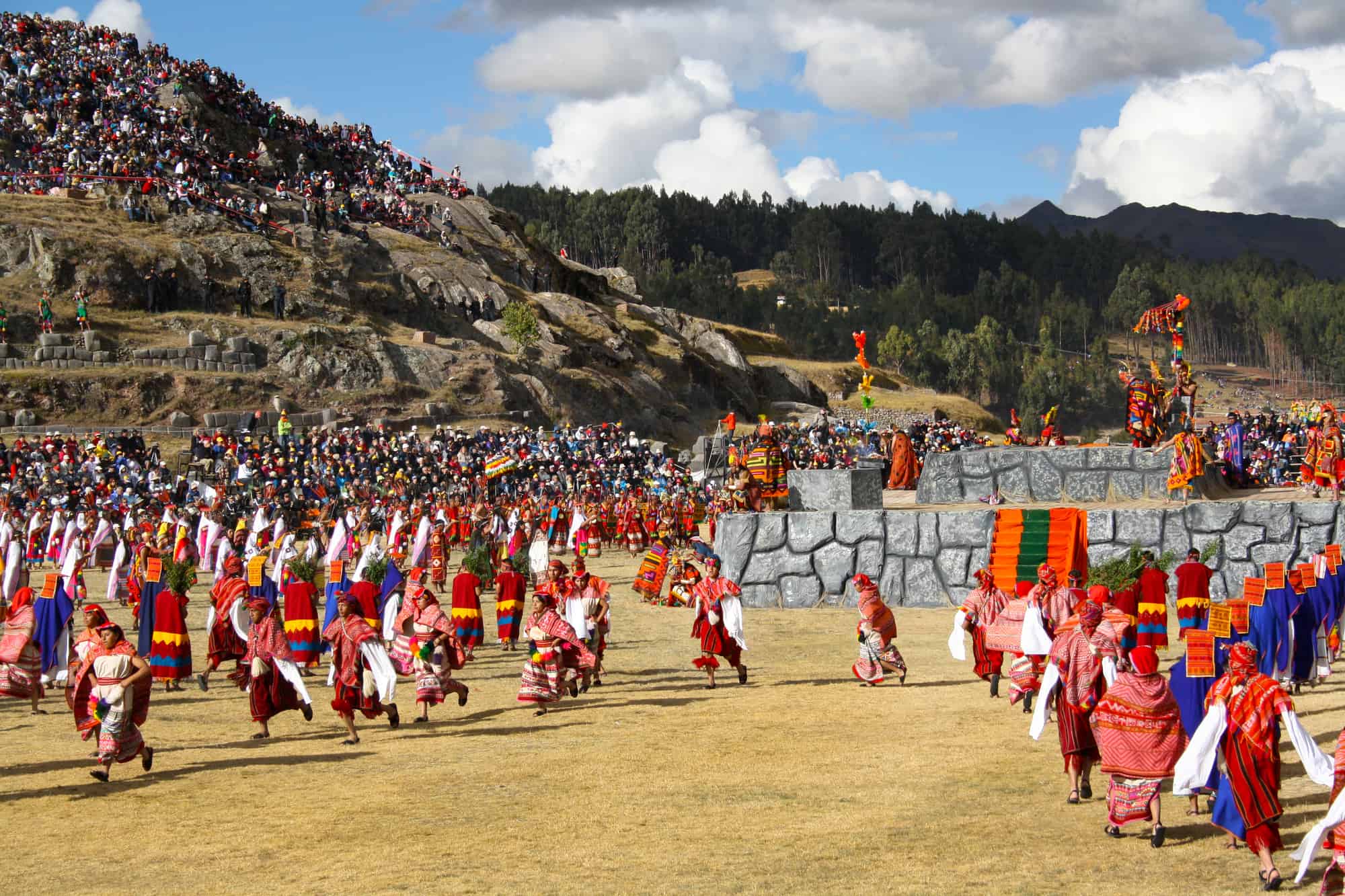
Peru’s festivals are a reflection of its deep-rooted traditions, blending Incan rituals, Catholic influences, and local folklore. Whether it’s the Inti Raymi Festival, honoring the Incan Sun God, or the lively Carnival in Cajamarca, filled with vibrant parades and water fights, these celebrations bring communities together. Each region has its own unique way of celebrating, making every festival a spectacular cultural experience.
Inti Raymi Festival, The Festival of the Sun
One of the most famous Cusco festivals and events, Inti Raymi is celebrated every June 24th to honor the Incan sun god, Inti. This UNESCO heritage event in Peru is a recreation of an ancient Andean pilgrimage tradition, featuring elaborate costumes, music, and traditional dances in the historic Sacsayhuamán fortress.
Fiesta de la Candelaria, Peru’s Largest Dance Festival
Held in Puno, this festival is a stunning display of Peruvian cultural traditions, featuring thousands of dancers and musicians performing in elaborate Andean costumes. It is deeply connected to the Lake Titicaca cultural events, blending Catholic culture in Lima with indigenous beliefs.
Semana Santa in Peru, A Holy Week Celebration
This Holy Week celebration in Peru is observed in cities like Cusco, Ayacucho, and Lima, where religious processions fill the streets. Semana Santa in Peru is one of the most significant religious festivals in Peru, attracting both locals and visitors who wish to experience the Catholic traditions of South America.
Qoyllur Rit’i, The Sacred Snow Star Festival
This Andean pilgrimage tradition is one of the most spiritual festivals in Peru, bringing together thousands of Quechua and Aymara communities to worship the sacred Ausangate mountain. Pilgrims dress in traditional Peruvian clothing, carrying offerings in a mix of indigenous and Catholic rituals.
Carnival in Cajamarca, Peru’s Most Colorful Celebration
This water fight and parade festival in Peru is known for its vibrant street parties, where locals and tourists take part in playful water fights, masked dances, and traditional Andean music. It is one of the liveliest celebrations in Cusco and other regions, attracting visitors from all over the world.
Peruvian Music, Dance & Folklore
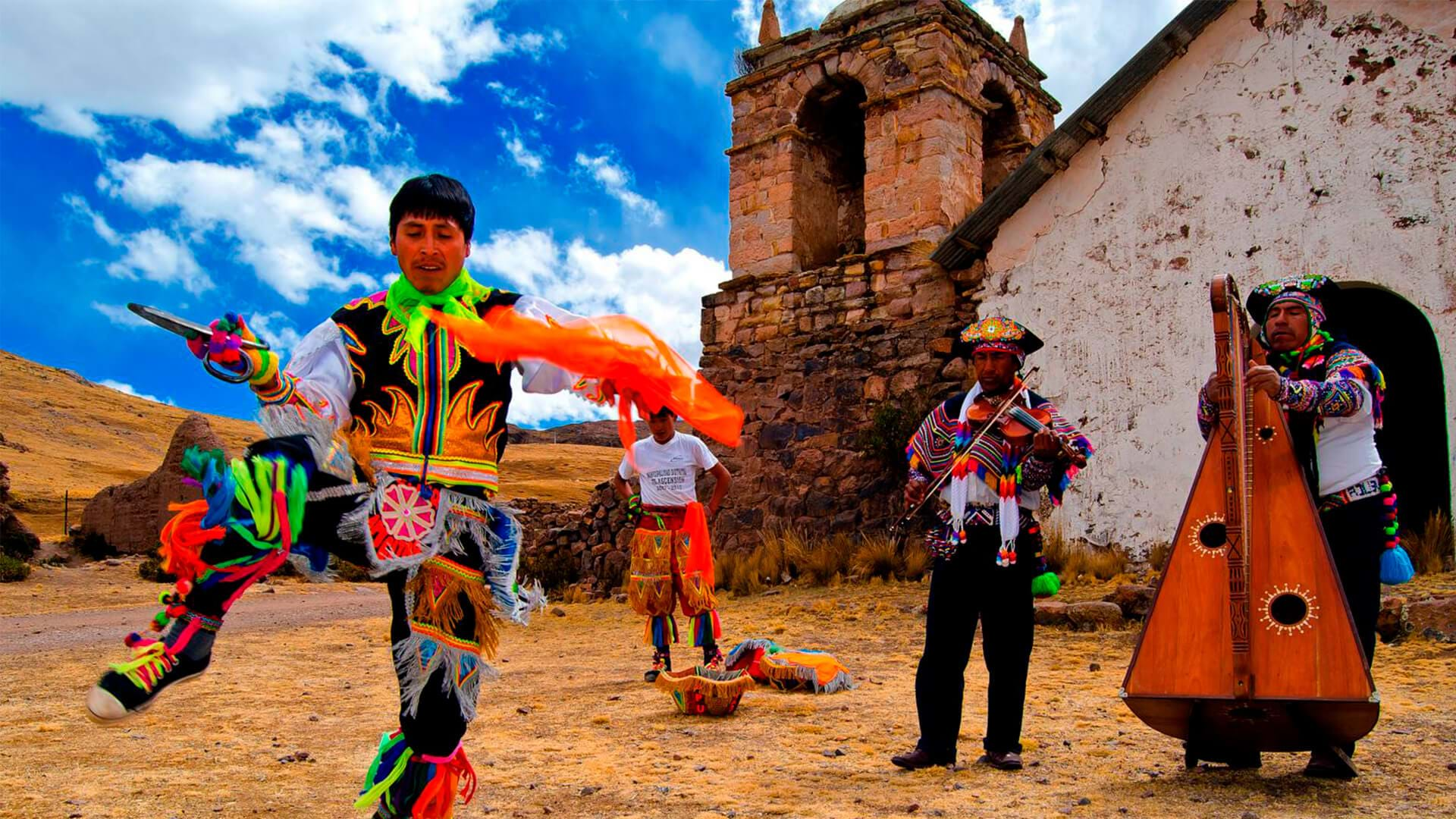
Music and dance are at the heart of Peruvian cultural experiences, showcasing influences from Andean, Spanish, and African traditions. From the elegant Marinera, often called the national dance of Peru, to the energetic Huayno performed in the highlands, each region offers a unique rhythm. Traditional instruments like the charango, panpipes, and cajón add to Peru’s rich musical heritage, making festivals an immersive experience for visitors.
The Ardah Dance, A Symbol of Peruvian Cultural Pride
A traditional Peruvian dance performed during heritage celebrations, Ardah symbolizes strength, unity, and folklore. Dancers wear colorful ponchos and embroidered skirts, moving rhythmically to drums, panpipes, and charangos. This dance is a highlight of Peruvian festivals in Cusco, Arequipa, and Puno, showcasing the country’s rich music and dance culture.
Mizmar, Traditional Andean Music and Dance
Mizmar is a high-energy Andean dance blending Incan rituals with folk traditions. Accompanied by drumming and wind instruments, performers wear feathered headdresses and woven textiles. It’s a major attraction at Inti Raymi, Virgen de la Candelaria, and other Peruvian folklore festivals, especially in Cusco and Puno.
Samri, The Dance of the Andes
Samri is a fusion of indigenous Andean and Spanish dance styles, performed in major Peruvian festivals. Featuring graceful footwork, gold-embroidered tunics, and masks, it tells stories of nature and Andean spirituality. Tourists can witness Samri at Inti Raymi, Cajamarca Carnival, and Virgen de la Candelaria celebrations.
Religious & Processional Events in Peru

Religious celebrations play a significant role in Peruvian life, blending Catholic traditions with indigenous customs. The Lord of Miracles Procession in Lima is one of the largest in South America, where thousands of devotees dress in purple to honor the Christ of Miracles. Meanwhile, the Fiesta de la Virgen de la Candelaria in Puno combines Catholic devotion with traditional Andean dance and music, creating a breathtaking spectacle of faith and folklore.
Lord of Miracles Procession, Peru’s Largest Religious Gathering
The Lord of Miracles Procession (Señor de los Milagros) is Peru’s most revered religious event, held every October in Lima. Thousands of devotees, dressed in purple robes, carry a massive sacred image of Christ through the streets in a grand display of Catholic faith. The tradition dates back to the 17th century, when an enslaved African man painted the image, which miraculously survived multiple earthquakes. The procession, filled with chants, incense, and prayers, moves through Lima’s historic center, attracting both locals and visitors to witness one of the largest Catholic festivals in South America.
Puno Week Festival, A Tribute to Lake Titicaca
Puno Week Festival, celebrated in November, honors Manco Cápac, the mythical founder of the Inca Empire. Puno, known as Peru’s Folklore Capital, comes alive with vibrant parades, traditional music, and masked dancers performing ancient Andean rituals. The festival’s highlights include boat races on Lake Titicaca, where locals compete using totora reed boats, and ceremonies dedicated to Pachamama (Mother Earth). A fusion of Incan and Aymara traditions, this festival showcases Peruvian folklore performances and the deep spiritual connection between the Andean people and their sacred lake.
Cultural Experiences in Peru
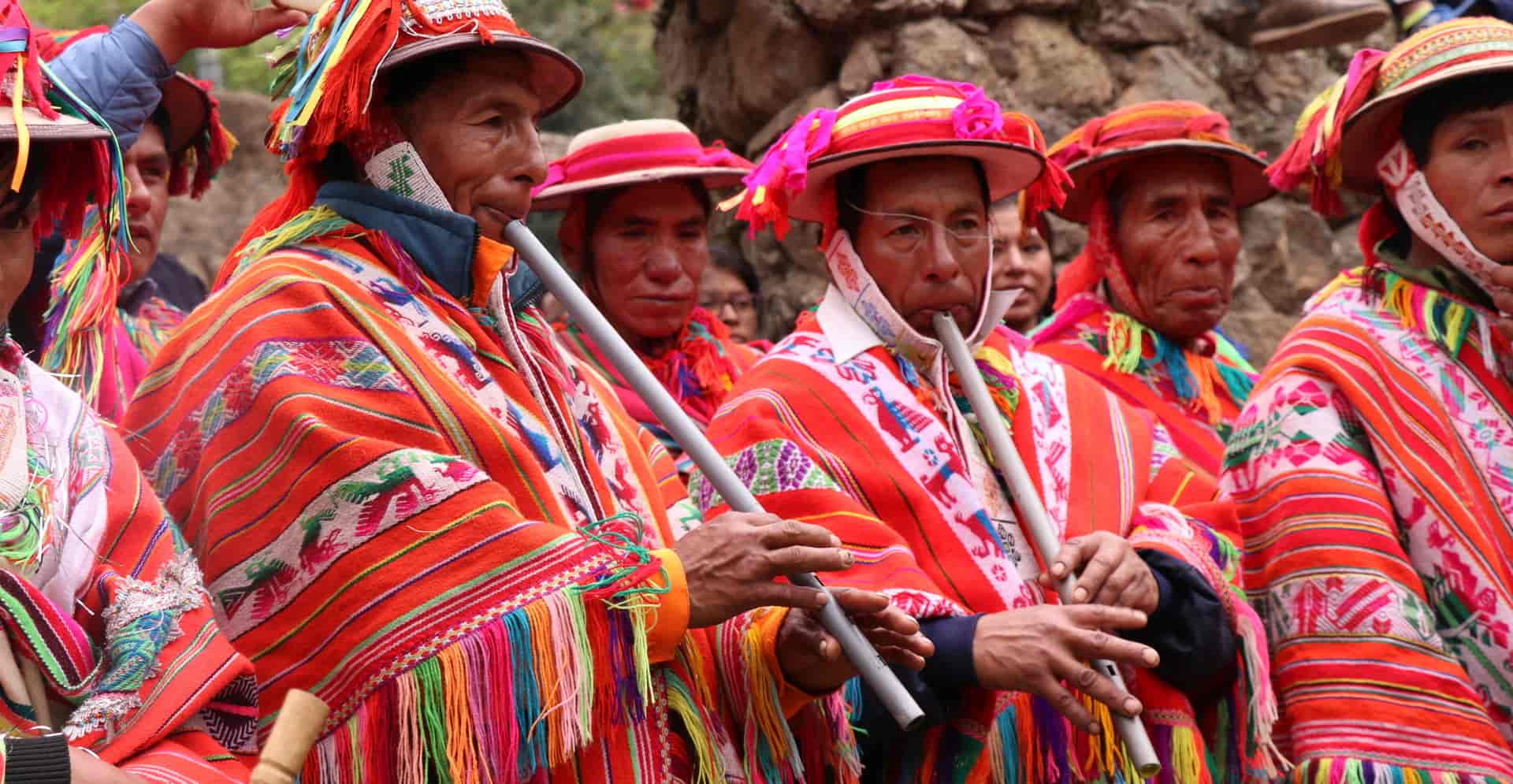
-
Traditional Peruvian Clothing & Textiles: In rural Andean communities, people still wear handwoven garments made from alpaca and vicuña wool, featuring intricate patterns and bright colors. Visitors can explore the Pisac Market or Cusco’s textile centers to see artisans at work.
-
Andean Spirituality & Shamanic Rituals: Ancient Incan traditions remain strong in Peru. Travelers can participate in Pachamama (Mother Earth) ceremonies led by local shamans, which involve offerings of coca leaves and natural elements to seek blessings and protection.
-
Folklore & Traditional Dance Performances: From the energetic Marinera of Trujillo to the haunting Scissors Dance of the Andes, Peru’s folk dances are a mix of indigenous and Spanish influences. Tourists can witness these performances at festivals, cultural centers, and special dance shows.
-
Peruvian Handicrafts & Artisan Markets: Peru is famous for handmade pottery, silver jewelry, and carved gourds (mates burilados). Popular places to buy authentic crafts include the San Blas district in Cusco, Ayacucho’s artisan workshops, and the markets in Puno.
-
Religious & Catholic Traditions: Peru’s Spanish colonial past has blended with indigenous beliefs, creating unique religious celebrations and processions like Semana Santa (Holy Week), Corpus Christi in Cusco, and the Lord of Miracles Procession in Lima.
Best Time to Visit Peru for Cultural Festivals & Experiences
| Festival / Event | Best Time to Visit | Why Visit During This Time? |
|---|---|---|
| Inti Raymi Festival | June 24 | Best time to witness Incan heritage celebrations in Cusco. |
| Fiesta de la Candelaria | February | Peru’s biggest dance and music festival. |
| Semana Santa in Peru | March – April | Major Catholic festival celebrated across Peru. |
| Qoyllur Rit’i Festival | May – June | Unique Andean pilgrimage tradition in the mountains. |
| Carnival in Cajamarca | February – March | Peru’s most vibrant water fight & parade festival. |
| Lord of Miracles Procession | October | Peru’s largest religious procession in Lima. |
| Puno Week Festival | November | Honors Lake Titicaca’s indigenous communities. |
Peru’s festivals and cultural experiences offer a deep dive into its rich heritage and traditions. From the Incan Sun Festival of Inti Raymi to the religious grandeur of Semana Santa, every celebration tells a story of Peru’s past and present. Whether you’re dancing in the Carnival of Cajamarca, witnessing the Lord of Miracles Procession, or experiencing folklore performances in Peru, these Peruvian heritage celebrations are unforgettable.
To truly immerse yourself in Peruvian lifestyle and traditions, time your visit during one of these famous Peruvian festivals and witness the magic of Andean culture firsthand!
FAQs
What is the most important festival in Peru?
Inti Raymi Festival is one of the most significant Peruvian heritage celebrations, honoring the Incan sun god every June in Cusco.
When is the best time to experience Peru’s cultural festivals?
The best time to visit Peru for festivals and cultural experiences is between June and November, when most traditional festivals in Peru take place.
Where can I see traditional Peruvian dances?
You can witness traditional Andean music and folklore performances in Peru during Fiesta de la Candelaria, Puno Week Festival, and Inti Raymi Festival.
What are the best religious festivals in Peru?
Semana Santa, Lord of Miracles Procession, and Qoyllur Rit’i Festival are the most important religious festivals in Peru.
How can I experience Peru’s local traditions and customs?
Attend Peruvian festivals, visit Andean markets, witness Peruvian traditional dances, and participate in Lake Titicaca cultural events for an authentic experience.
